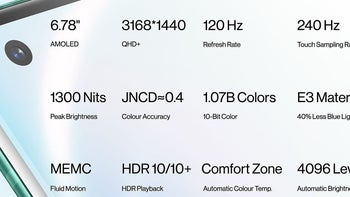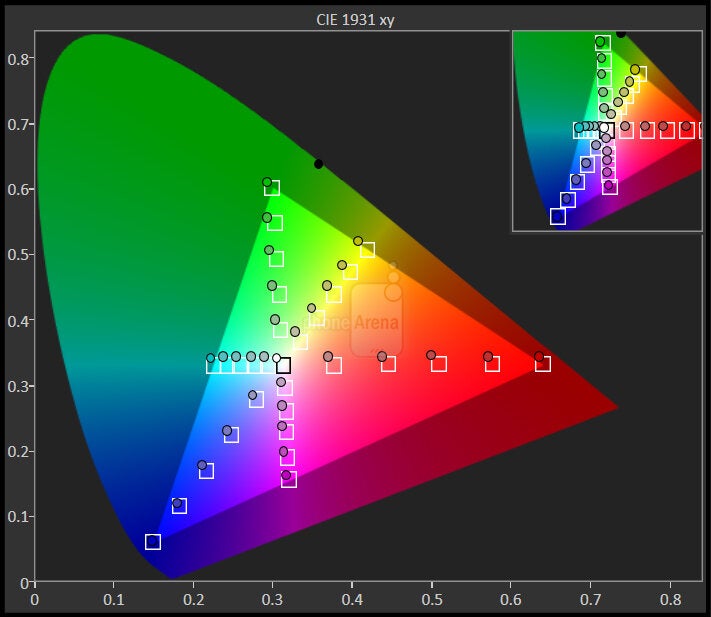OnePlus 8 Pro display review, or how the S20 Ultra 5G and iPhone 11 got beat

OnePlus is very proud of the display it chose to equip its 8 Pro handset with, as it already detailed in its 120 Hz Fluid Display deep dive, and, as you will see below, with a good reason. We can easily call it the best mobile display you can currently get on a phone in the US, and will show you way. The OnePlus 8 and 8 Pro were officially announced yesterday, via an online streaming event.
- iPhone 13 leaks, release date, price, and specs
The OnePlus 8 Pro carries a 6.78" 1440p panel sourced by Samsung, but with added post-production color calibration and refresh rate management on the hardware level, unlike the Galaxy S20 series.
The panel is currently the best that Android can offer in terms of overall features and color science thanks in no small part to the custom Iris 5 chip from Pixelworks inside, and the chip maker has been teasing us about its presence in the phone for a while now with this promo video:
See the technology behind the best smartphone displays in the industry with more to follow REALLY, REALLY soon. pic.twitter.com/8frATqo0Jo
— Pixelworks, Inc. (@pixelworksinc) April 10, 2020
All the new OnePlus 8 Pro Fluid 120Hz Display features
Among marketing promises that the "OnePlus's new 120 Hz Fluid Display will be the best you’ll lay eyes on in 2020," there are tangible arguments for the claim, like 120Hz at 1440p, 1000+ nits of peak brightness, and hardware components that allow a variable refresh rate based on what you are doing to save on battery.
120Hz at the full QHD+ resolution
Unlike the Galaxy S20 Ultra, the OnePlus 8 Pro display can be driven with a 120Hz refresh rate at the full 1440p screen resolution. How was OnePlus able to do this if Samsung wouldn't for the S20 series, even though the panel is supplied by Samsung?
According to AnandTech, Samsung didn't splurge on hardware components like "additional MIPI interfaces between the SoC and the display controller IC," and that is why the S20 series is unable to run its display at 120Hz in full QHD+ resolution, unlike the panel on the OnePlus 8 Pro.
Unlike the S20 series, however, the 6.78" panel of the 8 Pro comes with the latest dedicated Iris 5 visual processor from Pixelworks that sits between the display controller and the system graphics chip. Here's how Pixelworks describes what it does:
- For local videos, movies or live-streaming, Iris 5 with dual MIPI offers a smart MotionEngine that can detect and compensate for frame rate mismatch to offer blur-free content in real-time while processing the graphical and video layers separately. This also enhances gaming experiences with smooth, judder-free viewing.
- HDR10 is mostly supported in premium devices, but with Iris 5 which supports native 10-bit processing can offer certified HDR10 and HDR10+ playback with most accurate tone mapping for mid-tier budget devices. For all other content, an Always-on HDR experience, converts standard video or game SDR (16 million color shades) content to HDR (one billion color shades) in real-time for a richer, more immersive viewing.
- Iris 5’s Auto Adaptive Display capability adjusts the light, tone, and temperature based on different scenarios. For instance, in bright outdoor conditions, the brightness and contrast will be enhanced for ease of viewing. Similarly, at night or in ambient lighting conditions, the screen brightness will be dimmed dynamically while also reducing blue light to ease the strain on your eyes.
These are all features that the OnePlus 8 Pro takes full advantage of, including the adaptive color, brightness and white balance on-the-go adjustments.
Variable automatic refresh rate depending on content
Moreover, while Samsung has apparently placed a software stack that references various refresh rate levels - from 48Hz to 120Hz - but an automatic refresh rate solution hasn't been implemented for some reason, so the S20 Ultra stays either at 60Hz or at 120Hz at all times.
The OnePlus 8 Pro, however, has automatic refresh that defaults to, say, 120Hz when you are browsing, and drops to 60Hz when you are watching a frame-upscaled video. Thus, it is gentler on its battery in 120Hz mode than the S20 Ultra thanks to the auto refresh rate pick that the software will do, whereas the S20 runs the phone's display on 120Hz at all times.
Since video is usually shot at 24fps or 30fps, the 120Hz refresh can go to waste, but OnePlus used the Iris 5's chip custom motion estimation-motion compensation (MEMC) solution that can upscale lower frame rates to match the higher display refresh. Now, do you remember this January teaser from Pete Lau, the OnePlus CEO?
If you’ve seen high-quality TVs, you’re no stranger to MEMC. We’ve created a custom MEMC chip that can push ordinary 30fps video up to 120, so any video gets the full advantage of our 120Hz Fluid Display. pic.twitter.com/YPD3fw5uOn
— Pete Lau (@PeteLau) January 16, 2020
OK, you catch the drift, OnePlus splurged a bit extra on top of the price of the Samsung panel to install an Iris 5 chip between the 8 Pro screen's display controller and the Adreno GPU of the Snapdragon 865 processor. What about image quality, though?
OnePlus 8 Pro 'Best Display' color quality vs Galaxy S20 Ultra
So far so good, the main OnePlus 8 Pro vs Samsung Galaxy S20 Ultra 120Hz display specs differences are unequivocally giving it the win even before image quality tests:
- Battery life: 120Hz refresh impact should be better with adaptive (OnePlus) than frozen (S20 Ultra) rate.
- 120 Hz at full 1440p resolution: yes for OnePlus 8 Pro, no for Galaxy S20 Ultra.
- Content frame rate: OnePlus 8 Pro can upscale video to higher frame rates similar to MEMC TVs.
The advantage of using a hardware solution for on-the-fly adjustments of the 8 Pro's display resolution, refresh rate and color temperature didn't stop with buying the Iris 5 chip, though. Pixelworks is so adamant about its superior solution that it participates in the factory calibration process of each phone with the Iris gear inside, claims the company.
The results? Calibration within delta E < 1 of the targets in independent lab tests. Just look at what DisplayMate found out about the OnePlus 8 Pro display and shared with PCMag.
If you don't believe a display testing shop that gives A+ to each new major phone display, our own display benchmarks of the same 6.78" 1440p 120Hz screen but on the Oppo Find X2 Pro are demonstrating that the OnePlus CEO wasn't teasing when he said that it will be the "best smartphone display in 2020." Detailing the panel's virtues in a blog post, he also mentioned that:
In order to reach industry-leading color accuracy standards, we have added an additional automatic color calibration machine to the production line. By adding an extra 30 seconds to the production time, each display panel is automatically calibrated for color accuracy before it’s released.
Ring a bell? Yes, that's the same per-unit factory calibration that Pixelworks says they do for phones equipped with their Iris display solutions. That same OnePlus 8 Pro display that is on the X2 Pro and has gone post-production calibration covers the standard gamut more accurately than the Galaxy S20 Ultra in the color chart below, especially the all-important greens, despite being produced by the same manufacturer, and it is also brighter.
Long story short. the OnePlus 8 Pro comes with the best display you can currently get on a phone in its price bracket. Granted, the color distribution chart that the iPhone 11 Pro Max returned in our tests is slightly better but that panel is no match in features like resolution or refresh rate values and adaptive execution. The Galaxy S20 Ultra can match those added features on paper, but not on execution.
Given how important the display is on a 6.78" phone like the 8 Pro, we are glad that OnePlus went the extra mile to ensure that the most important part of its phone is as good as current technology allows.
— OnePlus USA (@OnePlus_USA) April 14, 2020




























Things that are NOT allowed: